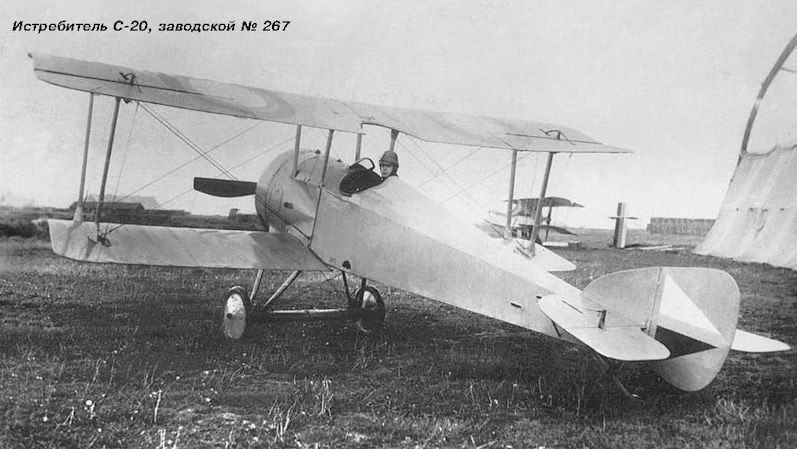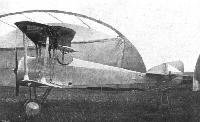М.Маслов Русские самолеты Первой Мировой (Эксмо)
С-20 (РБВЗ С-XX)
С учетом опыта создания С-16, в 1916 г. Сикорский спроектировал и построил самолет-истребитель С-20. Это был биплан чистых аэродинамических форм с небольшим превышением размаха верхнего крыла над нижним крылом. Согласно данным В.Б.Шаврова всего изготовили пять экземпляров С-20 с двигателями «Рон» 120 л.с. Однако доподлинно известно только об одном таком аппарате, имеющем заводской №267. Самолет испытали в Эскадре воздушных кораблей в начале 1917 г. летчики Романов и Нижевский. В одном из полетов Нижевский на С-20 потерпел аварию, после чего аппарат вернули на РБВЗ для ремонта. Ремонтом дело не ограничилось, машину установили на поплавки, однако далее история продолжения не имела.
Летные и технические характеристики С-20
Размах верхнего крыла (м) около 8,2
Длина (м) около 6,5
Площадь крыльев (мг) 17,0
Вес пустого (кг) 395
Полетный вес (кг) 570
Полетная скорость (км/ч ) 190
Показать полностью
В.Шавров История конструкций самолетов в СССР до 1938 г.
Самолет С-XX (С-20) - одноместный истребитель-биплан сначала с двигателем "Гном-Моносупап" в 100 л. с., потом двигателем "Рон" в 120 л. с. Верхнее крыло, несшее элероны, по хорде и размаху немного превышало нижнее. Самолет был построен сентябре 1916 г. в пяти экземплярах. Это был очень хороший самолет и по скорости он превосходил все "Ньюпоры", немного уступая лишь "Виккерсу". Самолет С-XX по своей конструкции и данным находился на уровне самой передовой техники 1916-1917 гг. К сожалению, в серии он не строился и остался почти неизвестным.
Гидросамолет И. И. Сикорского С-XX поплавковый. Один экземпляр его в 1917 г. устанавливался на поплавки такого же типа, как и на самолете С-5а. Работы не были закончены, гидросамолет не испытывался.
Самолет||С-XX
Год выпуска||1916
Количество двигателей||1
Двигатель, марка||
Мощность||120
Длина самолета, м||~6,5
Размах крыла, м||~8,2
Площадь крыла, м2||17
Масса пустого, кг||395
Масса топлива+ масла, кг||65
Масса полной нагрузки, кг||175
Полетная масса, кг||570
Удельная нагрузка на крыло, кг/м2||33,5
Удельная нагрузка на мощность, кг/лс||4,7
Весовая отдача, %||31
Скорость максимальная у земли, км/ч||190
Потолок практический, м ~7000
Показать полностью
А.Шепс Самолеты Первой мировой войны. Страны Антанты
В 1916 году был выпущен истребитель С-20 - одностоечный биплан рациональной, аэродинамически чистой конструкции с двигателем «Гном-Моносупап» (100 л. с.), позднее с двигателем «Рон» (120 л. с.).
Машина превосходила по летным данным истребители «Ньюпор» и «Сопвич» выпуска 1916 года. Технически машина соответствовала своему времени. Было построено 5 самолетов, поступивших в начале 1917 года на фронт.
Показатель С-20, 1916 г.
Размеры, м:
длина 6,5
размах крыльев 8,2
Площадь крыла, м2 17,0
Вес, кг:
максимальный взлетный 570
пустого 395
Двигатель: «Рон»
мощность, л. с. 120
Скорость, км/ч 190
Потолок практический, м 7000
Экипаж, чел. 1
Вооружение 1-2 пулемета
Показать полностью
W.Green, G.Swanborough The Complete Book of Fighters
RBVZ S-XX Russia
Displaying some Nieuport influence, the S-XX single-seat fighter designed by Igor Sikorsky was a single-bay unequal-span unstaggered biplane of wooden construction with fabric skinning. Armament comprised a single synchronised 7,7-mm machine gun, and five S-XXs were built in September 1916. The first of these was powered by a 100 hp Gnome rotary, but the second and, presumably, the remaining three S-XXs received the 120 hp Le Rhone engine with which they were allegedly faster than the Nieuport 17. However, the S-XX was considered inferior to the newer enemy aircraft that had begun to appear at the Front, and, therefore, no series production was undertaken. The following data relate to the S-XX with the Le Rhone engine.
Max speed, 118 mph (190 km/h).
Time to 6,560 ft (2 000 m), 6.33 min.
Empty weight, 871 lb (395 kg).
Loaded weight, 1,257 lb (570 kg).
Span, 28 ft 2 1/2 in (8,60 m).
Length, 21ft 3 7/8 in (6,50 m).
Wing area, 182.99 sq ft (17,00 m2).
Показать полностью
H.Nowarra, G.Duval Russian Civil and Military Aircraft 1884-1969
In 1916, a 24-year-old engineer named N. N. Polikarpov was placed in charge of the ‘Ilya Muromets’ production at Russo-Baltic, and Igor Sikorski, having a little more time to spare, set about the design of a new single-seater fighter, the S.20. Developed both from the S.16 and the French Nieuport 17, at least two examples were built, one with an 80 h.p. Le Rhone engine and another with a 110 h.p. engine of the same manufacture. Powered by the latter unit, the S.20 had an outstanding performance, being capable of a maximum speed of 118 m.p.h. and a climb rate of 1,000 ft./min. However, the production of this fighter would have impinged upon the R.B.V.Z. heavy bomber programme, and the design was abandoned in favour of fighters of French origin.
The fate of the S.20 was not unique in early Russian aviation history, although the reason for other cases was not as straightforward, as it would appear that a number of Russian high officials received considerations from representatives of foreign aircraft manufacturers in return for preventing competition by the Russian industry. It is a sad fact that Russian units received French aircraft indifferently repaired after being damaged on the Western Front, while the goods were invoiced as new! Many Russian aircraft designs of great promise were abandoned and in some cases the designers suffered imprisonment for political reasons, even valuable men like Hackel, Ufimtzev, and many others, while the work of some, such as Olchovski, Slessarev, Steglau, Klimov, and Professor Botezat, was ‘lost’ in the desks of officials who should have been safeguarding the interest of the State.
Показать полностью
A.Durkota, T.Darcey, V.Kulikov The Imperial Russian Air Service (Flying Machines)
Igor Ivanovich Sikorsky
Sikorsky S-20
The S-20 was a single-seat fighter biplane fitted with a 100hp Gnome Monosoupape engine. Completed in September 1916, this machine closely resembled the Nieuport fighter being built under license in Russia. All available data claim the performance of the S-20 equaled the best fighters then operational on the eastern front. At least five machine were built and powered by a slightly larger 120hp Le Rhone engine.
There is evidence that suggests the Russian army liked the S-20. However, the license-built Nieuports were favored so that Igor Sikorsky and the R-BVZ plant would concentrate on production of the improved Il'ya Muromets bombers.
Sikorsky Aircraft Data
Model: S-17 S-18 S-19 S-20 S-21 (1st Grand) S-21 (2nd Grand) S-21 (3rd Grand)
Year: 1916 1916 1916 1916 1913 1913 1913
Engine(s) type: 150hp Sunbeam 150hp Sunbeam x2 150hp Sunbeam x2 120hp LeRhone 100hp Argus x2 100hp Argus x4 (2 push/2 trac.) 100hp Argus (tractor)
Length, m: - - 17.1 7.6 20 20 20
Wing Span, m: top/bottom 13.8 16.5/15.3 28 11.6 27/20 27/20 27/20
Wing Area, m2: 43.5 58 - 26.0 120 120 120
Wt. empty, kg: 845 1485 - 395 3000 3400 3500
Wt. fuel/oil, kg: 160 380 - 65 150 250 250
Wt. load, kg: 342 600 - 175 400 600 700
Wt. flying, kg: 1190 2100 - 570 3400 4000 4200
Wingload, kg/m2: 26.7 36.2 - 33.5 28.5 33 35
Powerload, kg/hp: 8.5 7 - 10 18 11 11.5
Speed, km/h: - - 115 190 80 90 90
Показать полностью









